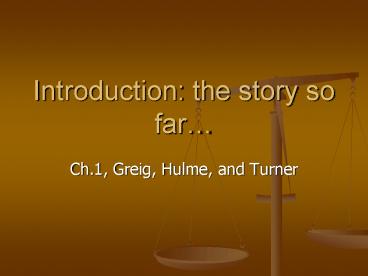Introduction: the story so far - PowerPoint PPT Presentation
1 / 9
Title:
Introduction: the story so far
Description:
Introduction: the story so far Ch.1, Greig, Hulme, and Turner Arguing about inequality Development studies emerged after WW2 concerned with bridging the gap ... – PowerPoint PPT presentation
Number of Views:91
Avg rating:3.0/5.0
Title: Introduction: the story so far
1
Introduction the story so far
- Ch.1, Greig, Hulme, and Turner
2
Arguing about inequality
- Development studies emerged after WW2
- concerned with bridging the gap between richer
and poorer countries through economic growth - By 1970s there was less enthusiasm
- Development gap persists into the 21st century
- Global inequality trails the career of modern
development policy as its dark shadow
3
An overview of global inequality
- UNs Human Development Report 2003 provides a
useful classificatory scheme for looking at - Inequality across countries, within countries,
and across the worlds people - Economic statistics
4
Inequalities across nations
- Richer countries produce over 4/5ths of the
worlds measurable Gross National Product - Remaining one fifth concentrated in East Asia
- GNP per head less than USD100 in Ethiopia,
Democratic Republic of Congo, Burundi - GNP per head more than USD35,000 in Japan,
Norway, Switzerland, and Luxembourg
5
- Global per capita income trebled from 1960-1990s,
but since the 1980s there were over 100 countries
whose per capita declined. - Countries with a declining per capita their
share of world exports declined, food production
per capita decreased, their infrastructure had
deteriorated. - Richer countries dominate international
institutions (e.g. IMF, WTO) - Inequality of power to dictate the rules of
global trade
6
Inequalities within countries
- UNDP estimates that 53 countries (containing 80
of world population) experienced rising
inequality - Narrowing only occurred in 9 countries
- Gini Index measuring inequality.
- Equal income distribution is assigned value 0
- Country where one person has all income is
assigned 100 - Japan, Denmark, Hungary (Gini lt 25)
- Brazil, Nicaragua, Bostwana, Swaziland, Central
African Republic, Sierra Leone (Gini gt 60) - Japan poorest 20 receive 10.6 of income
richest 20 receive 35.7 - Brazil and Bostwana poorest 20 receive just
over 2 and the richest 20 per cent account for
over 70 of income . - Mexico richest persons income equals 17 million
poorest citizens - Phenomenon also spreading to richer countries
7
Inequalities across the worlds people
- Global indicators of inequality
- The principal polarity is not between rich and
poor countries, but between rich and poor people
across the world - Globalization of production and trade raised the
salience of inequalities across nations and
classes - Richest 20 of the worlds population accounted
for 70 of income in 1960 - By 1991 this share increased to 85
- Meanwhile the bottom 20 per cent declined from
2.3 per cent to 1.4 per cent. - By the end of the millenium, wealthiest 5 earned
114 times as much as the poorest 5 - Top 1 earned the equivalent of the bottom 57
- Technological efficiency will reduce the employed
to 20, 80 of humanity will be unemployed
therefore poor. - Some claim we are already in a 2/3rds society
bottom third denied meaningful participation in
formal economic activities - Regressive distribution of income and wealth
8
The paradox of modernity the polarization of
affluence and deprivation
- But the world has never been so wealthy
- Productivity is at unprecedented levels
- Higher living standards
- But inequality has increased and one fifth of the
worlds population has gone backward economically - Gap between unprecedented affluence and
remarkable deprivation - Digital divide (by the turn of the millenium,
while 50 percent of US citizens had internet
access, the corresponding figure for Africa 0.4
per cent. - Chapters 5 and 6 of the book deal with history of
development theory - endogenous approach adopts an individualistic
perspective on development (no international
context) - Interconnected nature of global inequality.
Structural (exogenous) perspective global
inequalities are an inherent characteristic of
development (inequality is the other side of the
coin of progress) - While individualist approaches tend to focus on
the material, cultural or psychological
attributes of the poor, the more structural
approaches target how wealth perpetuates
inequalities.
9
Debating Development in the 21st Century
- Trillions of dollars of aid transferred to poorer
countries have not brought development - Disillusionment with progress and development
- Millennium Development Goals (MDGs) aims to
halve global poverty by 2015 - Traumatic changes also in the wealthier parts of
the world - Wealthy countries experienced economic change and
social dislocation - World might be overshooting its ecological
threshold - Development contributing to global environmental
problems - Greenhouse gases, desertification, loss of
biodiversity, salinity, water scarcity, air
pollution, disease transmission - Non-renewable resources depletion































